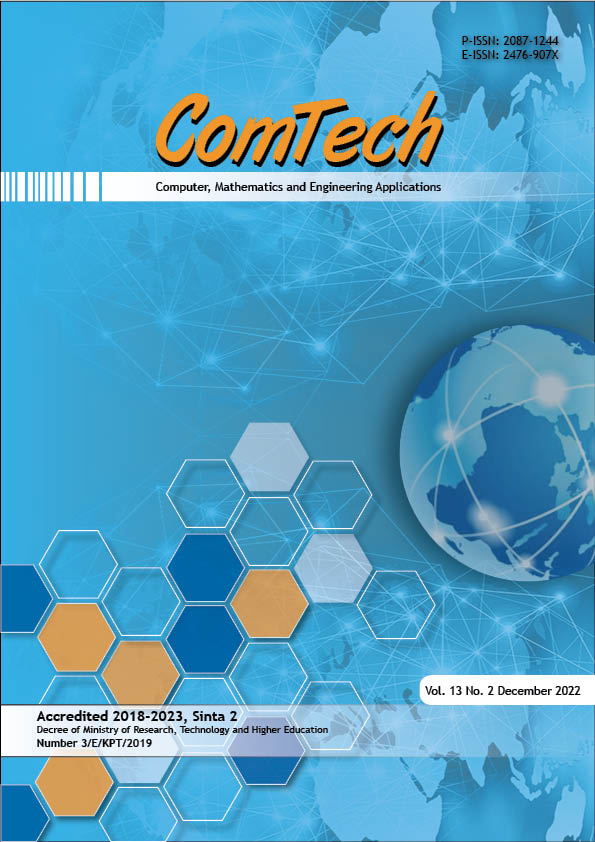Implementation of Fuzzy Mamdani Method to Classify Public Health Level in North Sumatra Province
DOI:
https://doi.org/10.21512/comtech.v13i2.7753Keywords:
Fuzzy Mamdani method, public health level, North Sumatra ProvinceAbstract
Health is one of the most important fields aspects in people’s lives. Public health is influenced by several factors, such as environmental factors and lifestyle. Every year, the government makes a program to improve people’s health and welfare. Therefore, the government needs to obtain information about the classification of public health levels to monitor the progress of the programs that have been carried out. The research created an interface application to classify the level of public health in North Sumatra Province. The research classified the public health level using data from Badan Pusat Statistik (BPS) in 2018. Next, the application was made using the Matlab 2013b GUI. Classification of the level of public health was carried out using the Fuzzy Mamdani method that generated public health classification levels based on the inputted indicators. Then, the level of health classification was divided into four parts: low, lower middle, upper middle, and high. The result shows that for the 2018 data, some cities/ districts are still at low health levels. However, many cities or districts have good health levels. The final result can be used as a reference for the government to analyze which cities/districts should be paid attention to improve their health and welfare.
References
Abd Halim, S., & Lazim, S. M. (2021). Development of GUI for Malaysian herbs plant image identification. Journal of Physics: Conference Series, 1988, 1−11. https://doi.org/10.1088/1742-6596/1988/1/012034
Ahmad Shukri, F. A., & Isa, Z. (2021). Experts’ judgment-based Mamdani-type decision system for risk assessment. Mathematical Problems in Engineering, 2021, 1−13. https://doi.org/10.1155/2021/6652419
Badan Pusat Statistik Provinsi Sumatera Utara. (2018). Provinsi Sumatera Utara dalam angka 2018. Retrieved from https://sumut.bps.go.id/publication/2018/08/16/6bb0847a56d2c3a34cf860b7/provinsi-sumatera-utara-
Batubara, S. (2017). Analisis perbandingan metode fuzzy Mamdani dan fuzzy Sugeno untuk penentuan kualitas cor beton instan. IT Journal Research & Development, 2(1), 1−11. https://doi.org/10.25299/itjrd.2017.vol2(1).644
Chusyairi, A., Saputra, P. R. N., & Zaenudin, E. (2021). Fuzzy C-Means clustering algorithm for grouping health care centers on diarrhea disease. International Journal of Artificial Intelegence Research, 5(1), 35−43. https://doi.org/10.29099/ijair.v5i1.191
Dinas Kesehatan Provinsi Sumatera Utara. (2021). Tekan angka kematian ibu dan bayi baru lahir, Pemprov Sumut jalin kerja sama dengan USAID. Retrieved from http://dinkes.sumutprov.go.id/artikel/tekan-angka-kematian-ibu-dan-bayi-baru-lahir-pemprov-sumut-jalin-kerja-sama-dengan-usaid-1633046400
Egaji, O. A., Griffiths, A., Hasan, M. S., & Yu, H. N. (2015). A comparison of Mamdani and Sugeno fuzzy based packet scheduler for MANET with a realistic wireless propagation model. International Journal of Automation and Computing, 12, 1−13. https://doi.org/10.1007/s11633-014-0861-y
Mugirahayu, A. S., Linawati, L., & Setiawan, A. (2021). Penentuan status kewaspadaan COVID-19 pada suatu wilayah menggunakan metode Fuzzy Inference System (FIS) Mamdani. Jurnal Sains dan Edukasi Sains, 4(1), 28−39. https://doi.org/10.24246/juses.v4i1p28-39
Pamuji, A. (2016). Assessment the method of fuzzy logic to determine the quality of service expedition in Jabodetabek area. Scientific Journal of Informatics, 3(2), 11−20. https://doi.org/10.15294/sji.v3i2.7906
Permana, Y., & Lelah. (2020). Pengklasifikasian tingkat kesejahteraan keluarga di Desa Citamiang dengan penerapan logika fuzzy model Tahani. RABIT: Jurnal Teknologi dan Sistem Informasi Univrab, 5(2), 97−107. https://doi.org/10.36341/rabit.v5i2.1318
Putri, S. N., & Saputro, D. R. S. (2021). Construction fuzzy logic with curve shoulder in inference system Mamdani. Journal of Physics: Conference Series, 1776, 1−8. https://doi.org/10.1088/1742-6596/1776/1/012060
Rahanyamtel, R., Nurjazuli, & Sulistiyani. (2019). Faktor lingkungan dan praktik masyarakat berkaitan dengan kejadian filariasis di Kabupaten Semarang. Jurnal Kesehatan Lingkungan Indonesia, 18(1), 8–11. https://doi.org/10.14710/jkli.18.1.8-11
Sari, F., Desyanti, Radillah, T., Nurjannah, S., Julimar, & Pakpahan, J. Y. (2021). Examining child obesity risk level using fuzzy inference system. International Journal of Public Health Science (IJPHS), 10(3), 679–687. http://doi.org/10.11591/ijphs.v10i3.20928
Wijirahayu, S., & Sukesi, T. W. (2019). Hubungan kondisi lingkungan fisik dengan kejadian demam berdarah dengue di wilayah kerja Puskesmas Kalasan Kabupaten Sleman. Jurnal Kesehatan Lingkungan Indonesia, 18(1), 19–24. https://doi.org/10.14710/jkli.18.1.19-24
Zulaikhah, S. T., Ratnawati, R., Sulastri, N., Nurkhikmah, E., & Lestari, N. D. (2019). Hubungan pengetahuan, perilaku dan lingkungan rumah dengan kejadian transmisi tuberkulosis paru di wilayah kerja Puskesmas Bandarharjo Semarang. Jurnal Kesehatan Lingkungan Indonesia, 18(2), 81–88. https://doi.org/10.14710/jkli.18.2.81-88
Downloads
Published
How to Cite
Issue
Section
License
Copyright (c) 2022 Sagita Charolina Sihombing, Agus Dahlia

This work is licensed under a Creative Commons Attribution-ShareAlike 4.0 International License.
Authors who publish with this journal agree to the following terms:
a. Authors retain copyright and grant the journal right of first publication with the work simultaneously licensed under a Creative Commons Attribution License - Share Alike that allows others to share the work with an acknowledgment of the work's authorship and initial publication in this journal.
b. Authors are able to enter into separate, additional contractual arrangements for the non-exclusive distribution of the journal's published version of the work (e.g., post it to an institutional repository or publish it in a book), with an acknowledgment of its initial publication in this journal.
c. Authors are permitted and encouraged to post their work online (e.g., in institutional repositories or on their website) prior to and during the submission process, as it can lead to productive exchanges, as well as earlier and greater citation of published work.
 USER RIGHTS
 All articles published Open Access will be immediately and permanently free for everyone to read and download. We are continuously working with our author communities to select the best choice of license options, currently being defined for this journal as follows:




















